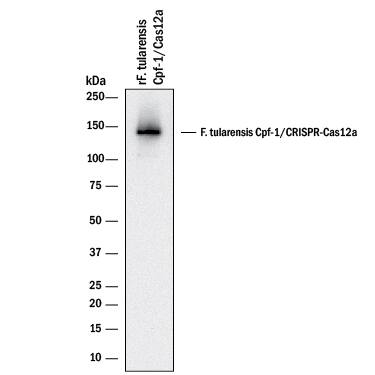CRISPR-Cas13a Antibody
R&D Systems, part of Bio-Techne | Catalog # MAB10463
Recombinant Monoclonal Antibody.

Key Product Details
Species Reactivity
Multi-Species
Applications
Western Blot
Label
Unconjugated
Antibody Source
Recombinant Monoclonal Rabbit IgG Clone # 2608C
Product Specifications
Immunogen
E. coli-derived recombinant CRISPR-Cas13a
Ser2-Asn1300
Accession # WP_003034647
Ser2-Asn1300
Accession # WP_003034647
Specificity
Detects CRISPR-Cas13a in direct ELISAs.
Clonality
Monoclonal
Host
Rabbit
Isotype
IgG
Scientific Data Images for CRISPR-Cas13a Antibody
Detection of CRISPR-Cas13a by Western Blot.
Western blot shows recombinant Francisella tularensis protein. PVDF membrane was probed with 1 µg/mL of Rabbit Anti-CRISPR-Cas13a Monoclonal Antibody (Catalog # MAB10463) followed by HRP-conjugated Anti-Rabbit IgG Secondary Antibody (HAF008). A specific band was detected for CRISPR-Cas13a at approximately 143 kDa (as indicated). This experiment was conducted under reducing conditions and using Western Blot Buffer Group 1.Applications for CRISPR-Cas13a Antibody
Application
Recommended Usage
Western Blot
1 µg/mL
Sample: Recombinant Francisella tularensis protein
Sample: Recombinant Francisella tularensis protein
Formulation, Preparation, and Storage
Purification
Protein A or G purified from cell culture supernatant
Reconstitution
Reconstitute at 0.5 mg/mL in sterile PBS. For liquid material, refer to CoA for concentration.
Formulation
Lyophilized from a 0.2 μm filtered solution in PBS with Trehalose. *Small pack size (SP) is supplied either lyophilized or as a 0.2 µm filtered solution in PBS.
Shipping
Lyophilized product is shipped at ambient temperature. Liquid small pack size (-SP) is shipped with polar packs. Upon receipt, store immediately at the temperature recommended below.
Stability & Storage
Use a manual defrost freezer and avoid repeated freeze-thaw cycles.
- 12 months from date of receipt, -20 to -70 °C as supplied.
- 1 month, 2 to 8 °C under sterile conditions after reconstitution.
- 6 months, -20 to -70 °C under sterile conditions after reconstitution.
Background: CRISPR-Cas13a
References
- Jinek, M. et al. (2012) Science 337:816.
- Zetsche, B. et al. (2015) Cell 163:759.
- Sandler J.D. and Joung J.K. (2014) Nat Biotechnol. 32:347.
- Koonin E.V. et al. (2017) Curr. Opin. Micrbiol. 37:67.
- Bayat H. et al. (2018) Curr. Micribiol. 75:107.
- Fonfara, I. et al. (2016) Nature 532:517.
- Moreno-Mateo, M.A. et al. (2017) Nat. Commun 8:2024.
- Joung K.J. et al. (2016) Nat. Biotechnol. 34:869.
- Kim, H et al. (2017) Nat. Commun. 8:14406.
- Kim, Y. et al. (2016) Nat. Biotechnol. 34:808.
- Port, F. and Bullock, S.L. (2016) Nat Methods 13:852.
- Cong, L. et al. (2013) Science 339:819.
Long Name
CRISPR-associated Endoribonuclease 13a
UniProt
Additional CRISPR-Cas13a Products
Product Documents for CRISPR-Cas13a Antibody
Product Specific Notices for CRISPR-Cas13a Antibody
For research use only
